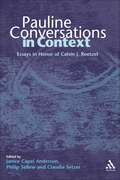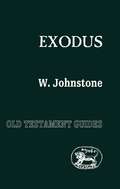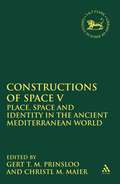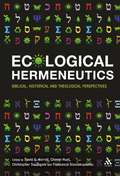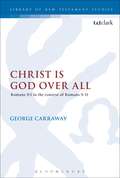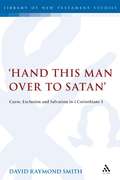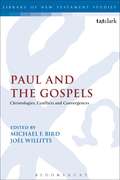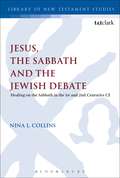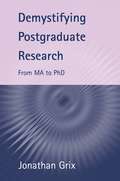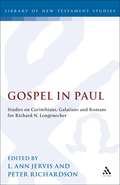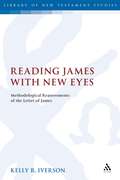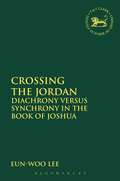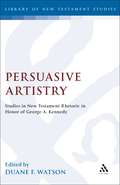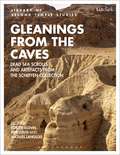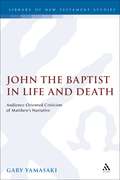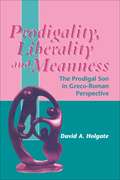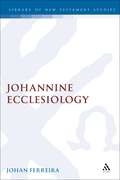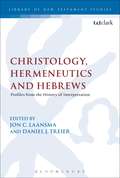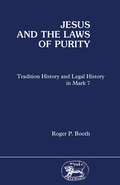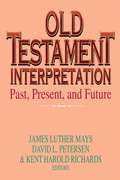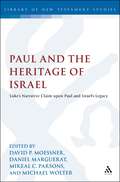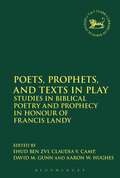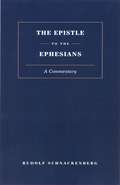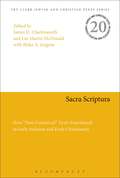- Table View
- List View
Pauline Conversations in Context: Essays in Honor of Calvin J. Roetzel (The Library of New Testament Studies #221)
by Janice Capel Anderson Philip Sellew Claudia SetzerThe "conversations" in this collection open by challenging ideas that have become standard and subject them to critical re-examination. The central thread of all these essays is a reflection on the processes of reading and theologizing. Among the contributors to this volume are David E. Aune, Jouette Bassler, Daniel Boyarin, Neil Elliott, Victor Paul Furnish, Lloyd Gaston, Steven J. Kraftchick, Robert C. Morgan, J. Andrew Overman, Mark Reasoner, Peter Richardson, and Robin Scroggs. Juanita Garciagodoy and David H. Hopper offer appreciations of Calvin Roetzel as a teacher and colleague.
Exodus (Old Testament Guides)
by William JohnstoneExodus requires the consideration not only of historical but also of institutional and theological questions. Since such disparate materials have all been brought together into one presentation, it is necessary also to look at the literary function and formulation of the book. In the light of these discussions it is possible to come to a clearer appreciation of the kind of work Exodus is.
Constructions of Space V: Place, Space and Identity in the Ancient Mediterranean World
by Gert T.M. Prinsloo Christl M. MaierThis is a collectionof papers given at SBL International Meetings 2009-2011, which investigate theinherent spatiality of human existence. The contributors discuss ancientMediterranean texts and societies from a decidedly spatial perspective,debating over such issues as narratological space, critical spatiality,sociological theories on space, space and identity, space and body. The volumeconsists of three parts and commences with three studies focusing ontheoretical approaches towards spatial analysis and application of the theoryto specific Old and New Testament texts. The essays in the second part examinethe sacred space and the formation of identity, with particular attention toJerusalem and the temple seen as sacred space and the lived experience of authors describing this space in variousways. The third part discusses the spatial theory and its application to avariety of texts ranging from the Epic of Gilgamesh to the New Testament.
Ecological Hermeneutics: Biblical, Historical and Theological Perspectives
by David G. Horrell Cherryl Hunt Christopher Southgate Francesca StavrakopoulouLeading scholars reflect critically on the kinds of appeal to the Bible that have been made in environmental ethics and ecotheology.
Christ is God Over All: Romans 9:5 in the context of Romans 9-11 (The Library of New Testament Studies #489)
by George CarrawayThis book is written against the background of Christological scholarly thought since thepublication of Kyrios Christos by Bousset. Carraway argues that the syntax of Romans 9:5 suggests Paul meant to refer to Jesus as God, and that his statement is not out of place at thebeginning of Romans 9-11.He addresses objections to this conclusion, responding to those who claim that a monotheist such as Paul would not refer to Jesus as God, and to those who point out that Paul does not elsewhere identify Jesus as God. After demonstrating that there is a connection between Romans 9:5 and the remainder of Romans 9-11, the argument continues by tying Paul's monotheistic statements regarding the one God of both Jews and Gentiles in Romans 3, the concept of the one Lord of all in Romans 10:5-13.The book concludes that the redeemer from Zion in 11:25-27 is Christ, and is the same as the Christ from Israel in 9:5.
'Hand this man over to Satan': Curse, Exclusion and Salvation in 1 Corinthians 5 (The Library of New Testament Studies #386)
by David Raymond Smith1 Corinthians 5:5 is a curious passage which has been variously interpreted by scholars. For some, it denotes a magical curse which is designed to cause the physical death of the sinner. Others have found such an interpretation unpersuasive. Instead, they maintain that Paul's words at verse five are to be understood as a metaphor for exclusion from the Corinthian community. So, the errant Corinthian is not to die by a curse, but is to be excluded. This work argues for the former interpretation by marshalling a range of the most recent-specialised-magical material, which has not been considered by other works in relation to 1 Corinthians 5. It fully acknowledges the weaknesses of previous magical interpretations, and metaphorical approaches to the passage. Instead, it presents a fresh magical reading of not only 1 Corinthians 5:5, but the whole of 1 Corinthians 5-within its wider context of the apostle Paul's letter to the Corinthians.
Paul and the Gospels: Christologies, Conflicts and Convergences (The Library of New Testament Studies #411)
by Michael F. Bird Joel WillittsThis volume, which collects together the work of several established scholars attempts to situate the Apostle Paul, the Pauline writings, and the earliest Christian Gospels together in the context of early Christianity. It addresses the issue of how the Christianity depicted in and represented by the individual Gospels relates to the vision of Christianity represented by Paul and the Pauline writings.This raises such questions as to what extent did Paul influence the canonical and non-canonical Gospels? In what way are the Gospels reactions to Paul and his legacy? A comparison of the Gospels and Paul on topics such as Old Testament Law, Gentile mission, Christology, and early church leadership structures represents a fruitful area of study. While a number of volumes have appeared that attempt to assess the relationship between the historical Jesus and the Apostle Paul relatively few studies on Paul and the Gospels have been published. This volume excellently fills this gap in New Testament Studies and makes a valuable contribution to studies on Christian Origins, Pauline research, and the Gospels.
Jesus, the Sabbath and the Jewish Debate: Healing on the Sabbath in the 1st and 2nd Centuries CE (The Library of New Testament Studies #474)
by Nina L. CollinsThe claim that Jesus was criticised by the Pharisees for performing cures on the Sabbath has been continuously repeated for almost 2,000 years. But a meticulous, unprejudiced evaluation of the relevant gospel texts shows that the historical Jesus was never criticised by historical Pharisees for performing Sabbath cures. In fact, Jesus and the Pharisees were in complete agreement for the need for cures on the Sabbath day. It is also clear that the Sabbath healing events in the gospels have preserved a significant part of the history of the early Jewish debate which sought to resolve the apparent conflict between the demands of Jewish law, and the performance of deeds of healing and/or saving life. This debate, from its Maccabean origins through to the end of the second century CE, is the subject of this book. The story of the debate has escaped the attention of historians partly because it relies on the evidence of both the early postbiblical Jewish texts and the Christian gospels, which are not generally studied together.
Demystifying Postgraduate Research: From Ma To Phd
by Jonathan GrixThe first complete introduction to the new model of social science and humanities postgraduate research. Based on the leading current course of postgraduate research training, a programme that will become the norm for postgraduate research over the next two or three years. Designed as a set text for '3 plus 1' and similar programmes.* The key tools and terminology of research * What to do before beginning the project * Funding * All about the student-supervisor relationship * The viva examination * The process of writing a thesis * Ethics and plagiarism in research, especially the use of the internet * How to get published
Gospel in Paul: Studies on Corinthians, Galatians and Romans for Richard N. Longenecker (The Library of New Testament Studies #108)
by L. Ann Jervis Peter RichardsonThis Festschrift in honour of Richard N. Longenecker (author of Paul, Apostle of Liberty, The Christology of Early Jewish Christianity, The Ministry and Message of Paul, Biblical Exegesis in the Apostolic Period, 'The Acts of the Apostles' in The Expositor's Bible Commentary, New Testament Social Ethics for Today, and Galatians, Word Biblical Commentary) is centered on the theme of 'gospel' in Paul. Notable Pauline scholars discuss 'gospel' from five different perspectives: the historical, the theological, the hermeneutical, the rhetorical and the epistolary; each author discusses one of these five perspectives within one part of Paul's correspondence: (1) Gospel in Romans (2) Gospel in Galatians and (3) Gospel in the Corinthian letters. The volume promotes discussion both on methods of reading Paul's letters and on important historical, theological and hermenutical issues.
Reading James with New Eyes: Methodological Reassessments of the Letter of James (The Library of New Testament Studies #342)
by Robert L. Webb John S. KloppenborgThe letters of James, 1 and 2 Peter, and Jude are among the most neglected letters of the New Testament. Thus, methodological advances in New Testament study tend to arise among the Gospels or Pauline letters. But now these letters are beginning to receive increased attention in the scholarly community. Reading James With New Eyes is the first of four volumes that incorporate new research in this area. The essays collected here examine the impact of recent methodological developments in New Testament studies to the letter of James, including, for example, rhetorical, social-scientific, socio-rhetorical, ideological and hermeneutical methods, as they contribute to understanding James and its social context. Each essay has a similar three-fold structure, making them perfect for use by students: a description of the methodological approach; the application of the methodological approach to James; and a conclusion identifying how the methodological approach contributes to a fresh understanding of the letter.
Crossing the Jordan: Diachrony Versus Synchrony in the Book of Joshua (The Library of Hebrew Bible/Old Testament Studies)
by Eun-Woo LeeThis book presents a test case for diachronic and synchronicapproaches in Joshua 3-4.Lee introduces the synchronic readings of Polzin, Hawk andWinther-Nielsen, as well as their attempts to uncover the problems in applyingtheir methods to this complicated text. He then investigates the differencesbetween the MT and the LXX of Joshua 3-4 through text critical analysis andreconstructs the Hebrew Vorlage of LXX - Joshua 3-4 considering divergencesbetween major Greek editions; and examines the limitations of Polzin'ssynchronic study in reading only from the final text of the MT. For the purposeof reading the literary history of Joshua 3-4 in a diachronic way, Leeconsiders what position this text holds in the setting of the wider context ofthe ark narratives and water-crossing stories in the Old Testament, e.g. thecrossing of the Red Sea in Exodus 13.17-14.31 and with Elijah and Elishacrossing the river in 2 kings 2. He examines the recent trends in literarycriticism and attempts to trace the most probable literary history of Joshua3-4.
Persuasive Artistry: Studies in New Testament Rhetoric in Honor of George A. Kennedy (The Library of New Testament Studies #50)
by Duane F. WatsonCrossing diverse strains of plants often yields a hybrid more vibrant than the parent strains. The same can be said of crossing diverse branches of knowledge, as in the integration of biblical and rhetorical studies that has produced the new hybrid of interpretative rhetorical criticism. This integration is due in no small measure to the creative efforts of George A. Kennedy. In this well-integrated volume of essays in his honour, 17 scholars display the influence of the approach taken by Kennedy and others upon the interpretation of the Gospels, Acts, Romans, 2 Corinthians, Galatians, and Ephesians.
Gleanings from the Caves: Dead Sea Scrolls and Artefacts from the Schøyen Collection (The Library of Second Temple Studies #71)
by Torleif Elgvin Michael Langlois Kipp DavisThis special edition large format LSTS volume presents, over half of them for the first time, ten biblical and five non-biblical fragments from the Judean Desert. The text features 42 photographs of the fragments. The publication of seven new fragments from the Judean Desert will supplement the Discoveries in the Judean Desert series and bring new material to scholars regarding the full textual situation. Two of the new biblical fragments suggest the preservation of substantial textual variants. The new Aramaic fragment reveals the use of interesting linguistic forms. The book includes a 10 page essay by Martin Schoyen about how he has tracked down and acquired Judean Desert fragments and artifacts since 1994. The collection of images, photographs of the fragments, and scholarly commentary from some of the leading experts in the field gives the reader a comprehensive picture of the artifacts from Qumran. The fragments included are: 4QLeviticusi, 4QSamueld, 4QDeuteronomy, and 4Q Twelve prophets; New (additional) fragments of 4QPsalmsq and 4QExodusc; improved version of XJudges frg 3, 4QJoshuac, 1QDanielb, and 4QJoshuac; Apochryphal fragments - 4QTobita and 1QapocrGenesis; and, Other fragments - 1QSb (Rule of Blessings, reedition), 11QTemplea, and 4QAramaic frg.
John the Baptist in Life and Death: Audience-Oriented Criticism of Matthew's Narrative (The Library of New Testament Studies #167)
by Gary YamasakiIn a narrative about Jesus, a character like John the Baptist would not be expected to play a role much beyond that of providing a baptism for Jesus. Yet the Matthaean narrator finds several other uses for John in the development of the narrative, not only while he is still alive, but also after he is dead. In examining John's role, Yamasaki deploys an audience-oriented critical methodology, an approach that chronicles the narrator's efforts to influence first-time readers' experience of the narrative as they proceed sequentially through the text. He traces John's characterization as 'forerunner', from a glowing introduction in ch. 3-albeit with a slight flaw in his ideological point of view on Jesus-through a progressive exacerbation of this flaw, to a rehabilitation of John in ch. 11. As a result of this rehabilitation, the narrator is able to continue to use John in his role as forerunner in the second half of the narrative, even after John's death has removed him from the story-line.
Prodigality, Liberality and Meanness: The Prodigal Son in Graeco-Roman Perspective (The Library of New Testament Studies #187)
by David HolgateThis monograph interprets the parable of the Prodigal Son (Lk. 15.11-32) in the light of Graeco-Roman popular moral philosophy. Luke's special parables are rarely studied in this way, but the results of this study are very fruitful. The unity of the parable is supported, and it is shown to be deeply concerned with a major Lukan theme: the right use of possessions. The whole parable is read in terms of the moral topos 'on covetousness', and shown to be an endorsement of the Graeco-Roman virtue of liberality, modified by the Christian virtue of compassion.
Johannine Ecclesiology (The Library of New Testament Studies #160)
by Johan FerreiraDuring the last few decades there has been a debate concerning the prominence of ecclesiology in the Gospel of John. This book highlights that debate and makes an important contribution to our understanding of Johannine ecclesiology. It argues that ecclesiology is a major theological concern of the Gospel, that investigations into Johannine ecclesiology have suffered under categories that are alien to the Gospel itself, and that the Gospel espouses a christological ecclesiology that emphasizes the origin, nature and purpose of the community. The community is Christus prolongatus; Christology and ecclesiology overlap. In addition, the book makes several new suggestions: that the prayer of the Johannine Jesus in John 17 has its origin (Sitz im Leben) in the 'law-court' petitionary prayers of the Johannine community in its conflict with the synagogue; that the Johannine concept of glory has to be understood in soteriological terms and is closely related to the Johannine community's sense of mission; and that the Johannine concept of sending reflects a gnostic sending tradition that was current in first-century Palestine.
Christology, Hermeneutics, and Hebrews: Profiles from the History of Interpretation (The Library of New Testament Studies #423)
by Jon C. Laansma Daniel J. TreierThis book discusses the history of the interpretation of the Letter to the Hebrews across the last two millennia. Beginning with the Patristic period, essays go on to examine the responses of Thomas Aquinas, Martin Luther, John Calvin, as well as more recent figures such as Karl Barth and contemporary global interpreters. The premise behind the work is to move study of Hebrews away from the perennial arguments about its authorship and provenance and to instead engage with it from a theological perspective, focusing upon the text's reception history. Consequently the issue of the Christological message in Hebrews is at the forefront and is considered both in terms of the interpreter's context and historical setting. At the end of the book the investigations are summarised and responded to by leading scholars Harold Attridge, Donald A. Hagner and Kathryn Greene-McCreight; providing a fitting conclusion to a radical academic project.
Jesus and the Laws of Purity: Tradition History and Legal History in Mark 7 (The Library of New Testament Studies #13)
by Roger P. BoothThe principal concern of this book is to show how uncovering the history of legal development can serve as a control for the conclusions of tradition history. In this groundbreaking study, the author brings his own professional experience as a lawyer to bear upon questions of Jewish law and of Gospel criticism. Dr Booth first establishes redaction-critically and form-critically which elements of Mark 7.1-23 are to be assigned to Mark, which to the early church, and which to the probable legal disputes of Jesus with the Pharisees. Then he charts the history of the purity laws, determining which legal statements in the text are credible in the situation of AD 30. This methodologically original approach enables him to formulate telling criticisms of some current procedures and conclusions of traditio-historical and form-critical scholars.
Old Testament Interpretation: Past, Present And Future (Old Testament Studies)
by James Luther Mays David Petersen Kent H. RichardsThis volume provides an introduction to the changing terrain of contemporary Old Testament Study. The essays orient the reader to all the major sections of Old Testament study, serving also to engage the reader in the work of Old Testament interpretation. The Festschrift in honour of Gene M. Tucker contains sections on the Torah, the Prophets, Writings, and the Context of the books of the Old Testament. The parts work in conjunction to give the reader a guide to the key issues in the history of interpretation of the Old Testament.
Paul and the Heritage of Israel: Paul's Claim upon Israel's Legacy in Luke and Acts in the Light of the Pauline Letters (The Library of New Testament Studies #452)
by David P. Moessner Daniel Marguerat Mikeal C. Parsons Michael WolterAs a sequel to the hugely successful Jesus and the Heritage of Israel, this book brings together fourteen internationally acclaimed scholars in antiquities studies and experts on Paul and Luke. The contributors provoke new approaches to the troubled relation of the Lukan Paul by re-configuring the figure and impact of Paul upon nascent Christianity, with the two leading questions as a driving force. First, 'Who is "Israel" and the "church" for Luke and Luke's Paul' and secondly 'Who is Jesus of Nazareth and who is Paul in relation to both?' The contributors provide challenging new perspectives on approaches to the figure of Paul in recent scholarship as well as in the scholarship of previous generations, 're-figuring' Paul by examining both how he is portrayed in Acts, and how the Pauline figure of Acts may be envisioned within Paul's own writings. Paul and the Heritage of Israel thus accomplishes what no other single volume has done: combining both the 'Paul of Paul' and the 'Paul of Luke' in one seminal volume.
Poets, Prophets, and Texts in Play: Studies in Biblical Poetry and Prophecy in Honour of Francis Landy (The Library of Hebrew Bible/Old Testament Studies #597)
by Ehud Ben Zvi Claudia V. Camp David M. Gunn Aaron W. HughesIn this volume, a list of esteemed scholars engage with the literary readings of prophetic and poetic texts in the Hebrew Bible that revolve around sensitivity to the complexity of language, the fragility of meaning, and the interplay of texts. These themes are discussed using a variety of hermeneutical strategies. In Part 1, Poets and Poetry, some essays address the nature of poetic language itself, while others play with themes of love, beauty, and nature in specific poetic texts. The essays in Part 2, Prophets and Prophecy, consider prophets and prophecy from a number of interpretive directions, moving from internal literary analysis to the reception of these texts and their imagery in a range of ancient and modern contexts. Those in Part 3, on the other hand, Texts in Play, take more recent works (from Shakespeare to Tove Jansson's Moomin books for children) as their point of departure, developing conversations between texts across the centuries that enrich the readings of both the ancient and modern pieces of literature.
Epistle to the Ephesians: A Commentary
by Rudolf SchnackenburgA classic ecumenical commentary on Ephesians. In addition to detailed exegesis, Schnackenburg pays special attention to the history of interpretation of Ephesians, taking account of comparative material in the history of religion and, at the end of each exegetical section, shows how findings are relevant for today. The theological focus is the concept of the church, giving rise to ecumenical discussion about ministry and office in the church. This commentary has proved invaluable for biblical scholars, clergy and theological students.
Sacra Scriptura: How "Non-Canonical" Texts Functioned in Early Judaism and Early Christianity (Jewish and Christian Texts)
by James H. Charlesworth Lee Martin McDonaldMany of the writings deemed 'apocryphal' and 'pseudepigraphical'were in circulation in the early centuries of Judaism and Christianity. Their influences and impacts on the development of early communities, and the development of Jewish and Christian thoughts, have not yet been sufficiently examined. While this judgment is especially true for the so-called Christian Apocrypha, it also applies for other writings that were not included in the Jewish and Christian Bibles and nor in other sacred collections of Scripture,like Rabbinics and Patristics. Most of these ancient writings functioned, to some degree, as sacred texts or scripture-sacra scriptura-in the communities in which they were produced and in others to which they circulated.This volume focuses on how some of these forgotten voices were heard within numerous early religious communities, helping to remove the distressing silence in many areas of the ancient world.
Materializing Literacies in Communities: The Uses of Literacy Revisited
by Kate PahlWhat is a 'contemporary' understanding of literacy practices? How can 'literacy' be explained and situated? This book addresses literacy practices research, understanding it as both material and spatial, based in homes and communities, as well as in formal educational settings. It addresses a need to update the work done on theoretical literacy models, with the last major paradigms such as critical literacies and multiliteracies developed a decade ago.Kate Pahl draws on case studies to highlight experiences alternate from the traditional representations of literacy. She argues that the affordances of home and familiar spaces offer fertile ground for meaning-making. These resultant literacies are multimodal and linked to space, place and community. An important evaluative resource, this book details a range of methodologies for further researching literacy, describing ethnographic, visual, participatory and ecological approaches, together with connective ethnographies. This volume will appeal to academics and professions in literacy studies and language and education.
